Упражнения на растягивание 2 страница
3. Сделайте выдох и наклоните голову к правому плечу.
4. Зафиксируйте растяжение и расслабьтесь.
5. Вы должны ощутить растяжение в латеральной части шеи.
Упражнение № 45
(Передняя часть шеи)
1. Лягте на спину на стол, чтобы голова свисала.
2. Зафиксируйте растяжение и расслабьтесь.
3. Вы должны ощутить растяжение в передней части шеи.
Упражнения на растягивание
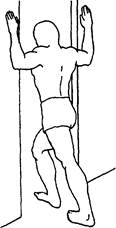
|
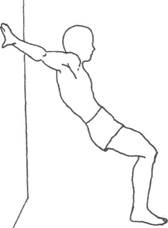
|
Упражнение№ 46
(Грудные мышцы)
1. Станьте прямо лицом к углу комнаты или дверному проему.
2. Поднимите руки в стороны, чтобы локти были на уровне плеч, а предплечья направлены строго вверх, упритесь ладонями в стену или дверной проем, чтобы растянуть грудинную часть грудных мышц.
3. Сделайте выдох и подайте все тело вперед.
4. Зафиксируйте растяжение и расслабьтесь.
5. Вы должны ощутить растяжение в верхней части груди (грудные мышцы).

Упражнение № 47 (Грудные мышцы)
1. Станьте на колени на полу лицом к стулу.
2. Переплетите предплечья над головой и наклонитесь вперед так, чтобы они оказались на стуле, голова опущена вниз.
3. Сделайте выдох и опустите голову и грудь к полу.
4. Зафиксируйте растяжение и расслабьтесь.
5. Вы должны ощутить растяжение в верхней части груди (грудные мышцы).
Упражнение № 48 (Передняя часть плеча)
1. Станьте прямо, руки сзади на уровне плеч на стене, пальцы направлены вверх.
2. Сделайте выдох и согните ноги, чтобы опустить плечи.
3. Зафиксируйте растяжение и расслабьтесь.
|
|
|
4. Вы должны ощутить растяжение в передней части плеч.

Упражнение№ 49
(Латеральная часть плеча)
1. Сядьте или станьте прямо, подняв одну руку на уровень плеча.
2. Согните руку по направлению к плечу другой руки.
3. Возьмитесь за поднятый локоть другой рукой.
4. Сделайте выдох и потяните локоть к спине.
Наука о гибкости
5. Зафиксируйте растяжение и расслабьтесь.
6. Вы должны ощутить растяжение в латеральной части плеча.

Упражнение № 50
(Внутренние вращатели плеча)
1. Сядьте прямо, прислонившись боком к столу.
2. Положите предплечье вдоль стола, рука согнута в локте.
3. Сделайте выдох, наклонитесь вперед и опустите голову и плечо на уровень стола.
4. Зафиксируйте растяжение и расслабьтесь.
5. Вы должны ощутить растяжение в верхней и медиальной частях плеча.
>\

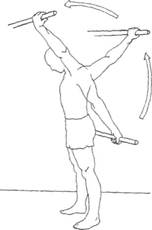
Упражнение № 52
(Внутренние и внешние вращатели плеча)
1. Станьте прямо, ноги в стороны, возьмите в руки шест или полотенце, руки находятся за спиной на ширине бедер, обратный хват.
2. Сделайте вдох и медленно поднимите руки над головой. Руки остаются прямыми и симметричными друг другу по мере их перемещения вперед в плечевом суставе, завершите хватом «L» (ладони обращены вверх, большие пальцы под шестом).
|
|
|
3. Сделайте вдох и выполните упражнение в обратную сторону.
4. Вы должны ощутить растяжение в области плеч (особенно в заднем участке).

Упражнение № 51
(Отводящие мышцы плеча)
1. Сядьте или станьте прямо, согнув одну руку за спиной.
2. Захватите локоть (или запястье, если вы не можете дотянуться до локтя) сзади другой рукой.
3. Сделайте выдох и потяните локоть через среднюю линию спины.
4. Зафиксируйте растяжение и расслабьтесь.
5. Вы должны ощутить растяжение в задней части плеча.
Упражнение № 53
(Внутренние и внешние вращатели плеча)
1. Станьте прямо, ноги в стороны, захватите шест или полотенце перед собой (ладони обращены вниз).
Упражнения на растягивание
2. Сделайте вдох и медленно поднимите руки над головой. Руки должны оставаться прямыми и симметричными друг другу по мере движения в плечевом суставе. Движение завершается, когда руки оказываются за головой.
3. Сделайте выдох и выполните упражнение в противоположном направлении.
4. Вы должны ощутить растяжение в области плеч (и особенно в передней части).
( \ Упражнение № 54
Л _ __ ____ 1 I (Двуглавые мышцы)
^|/<~v-^__г\ *>. 1. Станьте прямо
^^/ г/ спиной к дверной
\ /I коробке.
I /| 2. Положите одну ру-
/ ----- / ку на дверную ко-
|
|
|
I, II робку, рука враща-
4^"~~Y) ется вовнутрь в
\ плечевом суставе,
К _ 1 предплечье вып-
V / рямлено, кисть
I / пронирована и
} Д. большой палец
\>г направлен вниз.
3. Сделайте выдох и попытайтесь повернуть бицепс так, чтобы он оказался обращенным вверх.
4. Зафиксируйте растяжение и расслабьтесь.
5. Вы должны ощутить растяжение в области двуглавой мышцы.

Упражнение № 55
(Трехглавая мышца плеча)
1. Станьте прямо, предплечье лежит на столе, ладонь направлена вверх.
2. Сделайте выдох, наклонитесь вперед и приведите плечи к запястьям.
3. Зафиксируйте растяжение и расслабьтесь.
4. Вы должны ощутить растяжение в области трехглавой мышцы.

Упражнение № 56 (Трехглавая мышца плеча)
1. Сядьте или станьте прямо, согнув одну руку, локоть направлен вверх, кисть находится на лопатке.
2. Захватите локоть кистью другой руки.
3. Сделайте выдох и потяните локоть вниз.
4. Зафиксируйте растяжение и расслабьтесь.
5. Вы должны ощутить растяжение в области трехглавой мышцы.
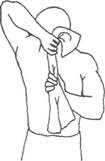
Упражнение № 57
(Трехглавая мышца плеча)
1. Станьте или сядьте прямо, одна рука находится у поясницы и максимально поднята вверх.
2. Поднимите другую руку над головой, держа в руке полотенце, и согните в локте.
|
|
|
3. Захватите край полотенца другой рукой.
4. Сделайте вдох и поочередно потяните руками полотенце.
5. Зафиксируйте растяжение и расслабьтесь.
6. Вы должны ощутить растяжение в области трехглавой мышцы.
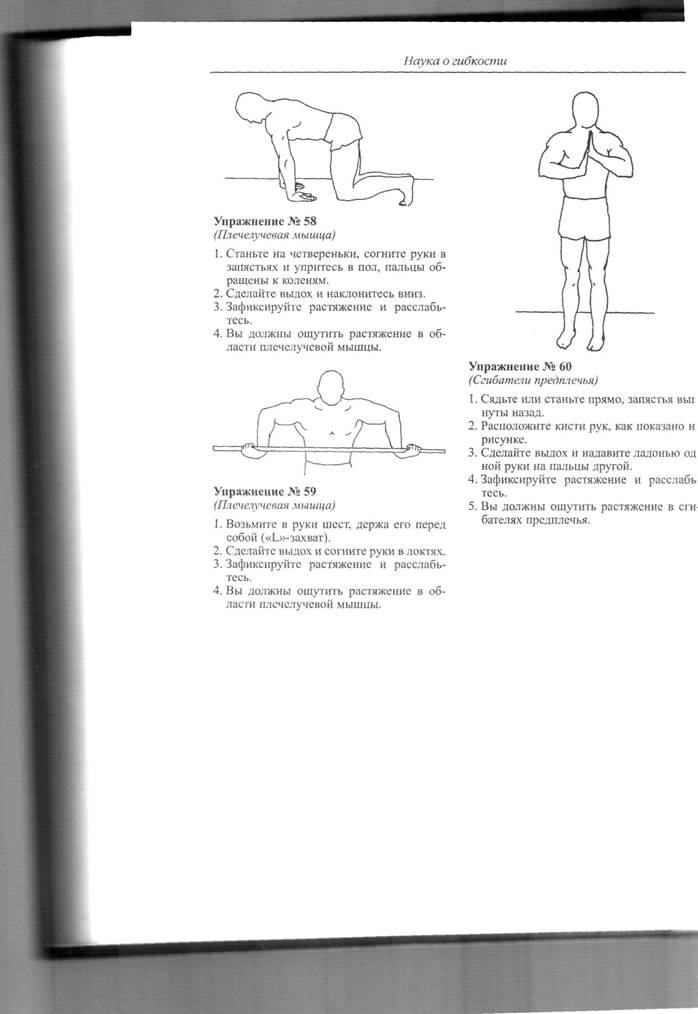
|

 ЛИТЕРАТУРА
ЛИТЕРАТУРА
Aarskog D., Stoa K.F., Thorsen T. (1966). Urinary oestrogen excretion in newborn infants with congenital dysplasia of the hip joint. Acta Paediatrica Scandinavica, 55(4), 394—397.
Aberdeen D.L., Joensen E. (1986). A study of the relevance of handedness to the range of rotation at the glenohumeral joint. European Journal of Chiropractic, 34(2), 67-87.
Abraham W.M. (1977). Factors in delayed muscle soreness. Medicine and Science in Sports, 9(1), 11-20.
Abraham W.M. (1979). Exercise-induced muscular soreness. The Physician and Sportsmedicine, 7(10), 57-60.
Abramson D., Roberts S.M., Wilson P.D. (1934). Relaxation of the pelvic joint in pregnancy. Surgery, Gynecology, and Obstetrics, 58(3), 595-613.
A COG. See American College of Obstetricians and Gynecologists.
Adams M.A., Dolan P., Hutton W.C. (1987). Diurnal variations in the stresses on the lumbar spine. Spine, 12(2), 130-137.
Adams M.A., Hutton W.C. (1986). Has the lumbar spine a margin of safety in forward bending? Clinical Biomechanics, 1(1), 3-6.
Adams M.A., Hutton W.C, StottJ.R.R. (1980). The resistance to flexion of the lumbar intervertebral joint. Spine, 5(3), 245-253.
Adams P., Muir H. (1976). Qualitative changes with age of proteoglycans of human lumbar discs. Annals of the Rheumatic Diseases, 35(4), 289-296.
Adler S.S., Beckers £>., Buck M. (1993). PNF in practice: An illustrated guide. New York: Springer-Verlag.
Agre J.C., Casal B.C., Leon A.S., McNally C, Baxter T.L., Serfass R.C. (1988). Professional ice hockey players: Physiologic, anthropometric, and musculoskeletal characteristics. Archives of Physical Medicine and Rehabilitation, 69(3), 188-192.
Agre J.C, Pierce L.E., Raab D.M., McAdams M., Smith E.L. (1988). Light resistance and stretching exercise in elderiy women: Effect upon stretch. Archives of Physical Medicine and Rehabilitation, 69(4), 273-276.
Akeson W.H., Amiel D., LaViolette D. (1967). The connective tissue response to immobility: A study of the chondroitin 4-and 6-sulfate and dermatan sulfate changes in periarticular connective tissue of control and immobilized knees of dogs. Clinical Orthopaedics and Related Research, 51,183-197.
Akeson W.H., Amiel D., Mechanic G.L., Woo S., Harwood F.L., Hammer M.L. (1977). Collagen crosslinking alteration in joint contractures: Changes in reducible crosslinks in periarticular connective tissue collagen after nine weeks of immobilization. Connective Tissue Research, 5(1), 15-20.
Akeson W.H., Amiel D., Woo S. (1980). Immobility effects on synovial joints: The patho-mechanics of joint contracture. Biorheology, 17(1/2), 95-110.
Akster H.A., Granzier H.L.M., Focant B. (1989). Differences in I band structure, sarcomere extensibility, and electrophoresis of titin between two muscle fiber types of the perch (Perca fluviatilis L.). Journal of Ultrastructure and Molecular Structure Research, 102(2), 109-121.
Alabin V.G., Krivonosov M.P (1987). Excerpts from training aids and specialized exercises in track and field. Soviet Sports Review, 22(2), 73-75.
24 Ы11
 Наука о гибкости
Наука о гибкости
Alexander M.J.L. (1991). A comparison of physiological characteristics of elite and sube-lite rhythmic gymnasts. Journal of Human Movement Studies, 20(2), 49-69.
Alexander RM. (1975). Biomechanics. London: Chapman and Hall.
Alexander R.M. (1988). Elastic mechanisms in animal movement. Cambridge: Cambridge University Press.
Allander E., Bjornsson O., Olafsson O., Sigfusson N.. Thorsteinsson J. (1974). Normal range of joint movements in shoulder, hip, wrist and thumb with special reference to side: A comparison between two populations. International Journal of Epidemiology, 3(3), 253-261.
Allen C.E.L. (1948). Muscle action potentials used in the study of dynamic anatomy. British Journal of Physical Medicine, 11, 66-73.
Almekinders L.C. (1993). Anti-inflammatory treatment of muscular injuries in sports. Sports Medicine, 15(3), 139-145.
Alnaqeeb M.A., Al Zaid N.S., Goldspink G. (1984). Connective tissue changes and physical properties of developing and aging skeletal muscle. Journal of Anatomy, 139(4), 677-689.
Al-Rawi Z.S., Al-Aszawi A.J., Al-Chalabi T. (1985). Joint mobility among university students in Iraq. British Journal of Rheumatology, 24(4), 326-331.
Alter J. (1983). Surviving exercise. Boston: Houghton Mifflin.
Alter J. (1986). Strength & strengthen. Boston: Houghton Mifflin.
Alter J. (1989-1990). Book review. Kinesiology and Medicine in Dance, 12(1), 41-43.
Alter M. (1990). Sport stretch. Champaign, IL: Leisure Press.
Alvarez R., Stokes I.A.F., Asprino D.E., Trevino S., Braun T. (1988). Dimensional changes of the feet in pregnancy. Journal of Bone and Joint Surgery, 70A(2), 271-274.
American Academy of Orthopaedic Surgeons. (1965). Joint motion: Method of measuring and recording. Park Ridge, IL: Author.
American Academy of Orthopaedic Surgeons. (1991). Athletic training and sports medicine (2nd ed.). Rosemont, IL: Author.
American Alliance for Health, Physical Education, and Recreation. (1968). School safety policies with emphasis on physical education, athletics, and recreation. Washington, DC: Author.
American Chiropractic Association. (1991). Chiropractic: State of the art 1991-1992. Arlington, VA: Author.
American College of Obstetricians and Gynecologists [ACOG]. (1985). Exercise during pregnancy and the postnatal period. ACOG home exercise programs. Washington, DC: Author.
American College of Obstetricians and Gynecologists [ACOG]. (1994). Exercise during pregnancy and the postpartum period (ACOG Technical Bulletin, No. 189). Washington, DC: Author. The American contortionist. (1882). Lancet, 1,618.
American Medical Association. Subcommittee on Classification of Sports Injuries. (1966). Standard nomenclature of athletic injuries. Chicago: Author.
American Orthopaedic Association. (1985). Manual of orthopaedic surgery. Chicago: Author.
Anderson B. (1978). The perfect pre-run stretching routine. Runners World, 13(5), 56-61.
Anderson B. (1980). Stretching. Bolinas, CA: Shelter.
Anderson B. (1985). Stretch: A key to body awareness. Shape. 4(3), 37-42.
Anderson M.B. (1979). Comparison of muscle patterning in the overarm throw and tennis serve. Research Quarterly 50(4), 541-553.
Andersson G.B.J., Herberts T.N., Ortengren R. (1977). Quantitative electromyographic studies of back muscle activity related to posture and loading. Orthopedic Clinics of North America, 8(1), 85-86.
Andren L., Borglin N.E. (1961). Disturbed urinary excretion pattern of oestrogens in new-boras with congenital dislocation of the hip. I. The excretion of oestrogen during the first few days of life. Acta Endocrinologica, 37(3), 423-433.
Andrews J.R. (1983). Overuse syndromes of the lower extremity. Clinics in Sports Medicine, 2(1), 137-148.
Ansell B.A. (1972). Hypermobility of joints. In A.G. Apley (Ed.), Modern trends in orthopaedics (pp. 25-39). New York: Appleton-Century-Crofts.
Armstrong C.G., O'Connor P., Gardner D.L. (1992). Mechanical basis of connective tissue disease. In D.L. Gardner (Ed.), Pathological basis of the connective tissue diseases (pp. 261-281). Philadelphia: Lea & Febiger.

 Литература
Литература
Armstrong J.R. (1958). Lumbar disc lesions. London: E & S Livingstone.
Armstrong R.B. (1984). Mechanisms of exercise-induced delayed onset muscle soreness. Medicine and Science in Sport, 9(1), 111-26.
Armstrong R.B., Ogilvie R.W., Schwane J.A. (1983). Eccentric exercise-induced injury to rat skeletal muscle. Journal of Applied Physiology, 54(1), 80-93.
Armstrong R.B., Warren G.L., Warren J.R. (1991). Mechanisms of exercise-induced muscle fibre injury. Sports Medicine, 12(3), 184-207.
Arner O., Lindholm A. (1958). What is tennis leg? Acta Chirargica Scandinavica, 116(1), 73-77.
Arnheim D.D. (1971). Stretching. In L.A. Larson (Ed.), Encyclopedia of sport sciences and medicine (pp. 165-166). New York: Macmillan.
Arnheim D.D. (1989). Modern principles of athletic training (7th ed.). St. Louis: Times Mirror/Mosby.
Ashmore C.R. (1982). Stretch-induced growth in chicken wing muscles: Effects on hereditary muscular dystrophy. American Journal of Physiology, 242 (Cell Physiology 11), C178-C183.
Asmussen E. (1953). Positive and negative work. Acta Physiologica Scandinavica, 28(4), 364-382.
Asmussen E. (1956). Observations on experimental muscle soreness. Acta Rheumatologica Scandinavica, 2,109-116.
Asmussen E., Bonde-Petersen F. (1974). Storage of elastic energy in skeletal muscles in man. Acta Physiologica Scandinavica, 91(3), 385-392.
Aspden R.M. (1988). A new mathematical model of the spine and its relationship to spinal loading in the workplace. Applied Ergonomics, 19(4), 319-323.
Asterita M.F. (1985). The physiology of stress. New York: Human Science Press.
Aten D.W, Knight K.T. (1978). Therapeutic exercise in athletic.training: Principles and overview. Athletic Training, 13(3), 123-126.
AthenstaedtH. (1970). Permanent longitudinal electric polarization and pyroelectric behaviour of collagenous structures and nervous tissue in man and other vertebrates. Nature, 228(5274), 830-834.
Atwater A.A. (1967, October). What film analysis tells us about movement. Paper presented at the Annual Meeting of the Midwest Association for Physical Education of College Women, French Lick, IN.
Atwater A.A. (1979). Biomechanics of overarm throwing movements and of throwing injuries. Exercise and Sport Sciences Reviews, 7,43-85.
AuberJ., Couteaux R. (1962). L'attache des myofilaments secondaires au niveau de la strie у dans les muscles de dipteres. Comptes Rendus des Seances de L'Academie des Sciences, 254, 3425-3426.
Auber J., Couteaux R. (1963). Ultrastructure de la strie у dans des muscles de dipteres. Journal de Microscopie, 2(3), 309-324.
Aura O., Komi P. V. (1986). Mechanical efficiency of pure positive and pure negative work with special reference to the work intensity. International Journal of Sports Medicine, 7(1), 44-49.
Baatsen PH., Trombitas W.K., Pollack G.H. (1988). Thick filaments of striated muscle are laterally interconnected. Journal of Ultrastructure and Molecular Structure Research, 98(3), 267-280.
Baddeley S., Green S. (1992). Physical education and the pregnant woman: The way forward. Midwives Chronicle & Nursing Notes, 105(1253), 144-145.
Badtke G, Bittmann E, Lazik D. (1993). Changes in the vertebral column in the course of the day. International Journal of Sports Medicine, 14(3), 159.
Balaftsalis H. (1982-1983). Knee joint laxity contributing to footballers' injuries. Physiotherapy in Sport, 5(3), 26-27.
Baldissera E, Hultborn H., lllert M. (1981). Integration in spinal neuronal systems. In Handbook of physiology. Sec. 1. The nervous system. (Vol. 2, Part 1, pp. 509-595). Bethesda, MD: American Physiological Society.
Ballantyne B. T, Reser M.D., Lorenz G. W, Smidt G.L. (1986). The effects of inversion traction on spinal column configuration, heart rate, blood pressure, and perceived discomfort. Journal of Orthopaedic and Sports Physical Therapy, 7(5), 254-260.
Наука о гибкости
Bandy W.D., Irion J.M. (1994). The effect of time on static stretch on the flexibility of hamstring muscles. Physical Therapy, 74(9), 845-850.
Banker LA. (1980). The isolated mammalian muscle spindle. Trends in Neuroscien 3(11), 258-265.
Barker D. (1974). The morphology of muscle receptors. In C.C. Hunt (Ed.), Handbook sensory physiology. Muscle receptors (Vol. 3, Part 2, pp. 1-190). New York: Springer.
BarnardR.J., Gardner G. W., Diaco N. V., McAlpin R.N., KattusA.A. (1973). Cardiovascul responses to sudden strenuous exercise-Heart rate, blood pressure and ECG. Journal of Applii Physiology, 34(6), 833-837.
Barnard R.J., McAlpin R., Kattus A.A., Buckberg G.D. (1973). Ischemic response to su> den exercise in healthy men. Circulation, 48(5), 936-942.
Barnes J. (1991). Myofascial release: Its importance to the massage therapy professio: Massage Message, 6(1), 4-7.
Barnett C.H. (1971). The mobility of synovial joints. Rheumatology and Physical Medicir 11 (February), 20-27.
Barnett J.G., Holly R.G., Ashmore C.R. (1980). Stretch-induced growth in chicken win muscles: Biochemical and morphological characterization. American Journal of Physiology, Ce. Physiology 8, 239, C39-C46.
Barney VS., Hirst C.C., Jensen C.R. (1972). Conditioning exercises: Exercises to improvi body form and function (3rd ed.). St. Louis: Mosby.
Barr M. (1979). The human nervous system, an anatomic viewpoint (3rd ed.). Hagerstown MD: Harper & Row.
Barrack R.L., Skinner H.В., Brunei M.E., CookS.D. (1983). Joint laxity and proprioceptior in the knee. The Physician and Sportsmedicine, 11(6), 130-135.
Barry W., Cashman R., Coote S., Hastings В., Imperatrice M. (1987). The relationship between lung function and tho-racic mobility in normal subjects. New Zealand Journal of Physiotherapy, 15(1), 9-11.
Bartelink D.L. (1957). The role of abdominal pressure in relieving pressure on the lumbar intervertebral discs. Journal of Bone and Joint Surgery, 39B(4), 718-725.
Basmajian J.V. (1963). Control and training of individual motorunits. Science, 141(3579), 440-441.
Basmajian J.V. (1967). Control of individual motor units. American Journal of Physical Medicine, 46(1), 480-486.
Basmajian J.V. (1972). Electromyography comes of age. Science, 176(4035), 603-609.
Basmajian J.V. (1975). Motor learning and control. Archives of Physical Medicine and Rehabilitation, 58(1), 38-^1.
Basmajian J. V (1981). Biofeedback in rehabilitation: A review of principles and practices. Archives of Physical Medicine and Rehabilitation, 62(10), 469-475.
Basmajian J. V, Baeza M., Fabrigar С (1965). Conscious control and training of individual spinal motor neurons in normal human subjects. Journal of New Drugs, 5(2), 78-85.
BasseyEJ., Morgan K., Dallosso H.M., Ebrahim S.B.J. (1989). Flexibility of the shoulder joint measured as range of abduction in a large representative sample of men and women over 65 years of age. European Journal of Applied Physiology, 58(4), 353-360.
Bates R.A. (1971). Flexibility training: The optimal time period to spend in a position of maximal stretch. Unpublished master's thesis. University of Alberta, Edmonton.
Bates R.A. (1976). Flexibility development: Mind over matter. In J.H. Salmela (Ed.), The advanced study of gymnastics (pp. 233-241). Springfield, IL: Charles С Thomas.
Battie M.C., Bigos S.J., Fisher L.D., Spengler D.M., Hansson Т.Н., Nachemson A.L., Wortley M.D. (1990). The role of spinal flexibility in back pain complaints within industry: A prospective study. Spine, 15(8), 768-773.
Battie M.C., Bigos S.J., Sheehy A., Wortley M.D. (1987). Spinal flexibility and individual factors that influence it. Physical Therapy, 67(5), 653-658.
Bauman P.A., Singson R., Hamilton W.G. (1994). Femoral neck ante version in ballerinas. Clinical Orthopaedics and Related Research, 302(May), 57-63.
Baxter C, Reilly T. (1983). Influence of time of day on all-out swimming. British Journal of Sports Medicine, 17(2), 122-127.
Литература
Baxter D.E., Davis P.F. (1995). Rehabilitation of the elite athlete. In D.E. Baxter (Ed.). The foot and ankle in sport (pp. 379-392). St. Louis: Mosby.
Beauchamp M., Labelle #., Grimard G, Stanciu C, Poitras В., Dansereau J. (1993). Diurnal variation of cobb angle measurement in adolescent idiopathic scoliosis. Spine, 18(12), 1581-1583.
Beaulieu J.E. (1981). Developing a stretching program. The Physician and Sportsmedicine, 9(11), 59-69.
Beccaria С W. (1764). On crimes and punishment (H. Paolucci,. Trans.). New York: Bobbs-Merrill, 1963.
Bechbache R.R., Duffin J. (1977). The entrainment of breathing frequency by exercise rhythm. Journal of Physiology (London), 272,553-561.
Becker A.H. (1979). Traction for knee-flexion contractures. Physical Therapy, 59(9), 1114.
Beekman S., Block B.H. (1975). The relationship of calcaneal varus to hamstring tightening. Current Podiatry, 24(11), 7-10.
Beel J.A., Groswald D.E., Luttges M. W. (1984). Alterations in the mechanical properties of peripheral nerve following crush injury. Journal of Biomechanics, 17(3), 185-193.
Beel J.A., Stodieck L.S., Luttges M.W. (1986). Structural properties of spinal nerve roots: Biomechanics. Experimental Neurology, 91(1), 30-40,1986.
Beighton P. (1971). How contortionists contort. Medical Times, 99(4), 181-187.
Beighton P., GrahameR., Bird H. (1983). Hypermobility of joints. Berlin: Springer-Verlag.
Beighton P., Horan F.T. (1969). Orthopaedic aspects of the Ehlers-Danlos syndrome. Journal of Bone and Joint Surgery, 51B(3), 444-453.
Beighton P., Horan, F.T. (1970). Dominant inheritance in familial generalized articular hypermobility. Journal of Bone and Joint Surgery, 52B(1), 145-147.
Beighton PH., Solomon L., Soskolne C.L. (1973). Articular mobility in an African population. Annals of the Rheumatic Diseases, 32(5), 413-4-18.
Bell R.D., Hoshizaki ТВ. (1981). Relationship of age and sex with range of motion of seventeen joint actions in humans. Canadian Journal of Applied Sports Science, 6(4), 202-206.
Bencke A. (1897). Zur Lewre von der Spondylitis deformans - Beitrag zur wis-senschaftlicher Medizin. Festschrift an der 59 Versammlung deutscher Naturforscher und Arete, Braundschweig, Germany.
Benjamin B.E. (1978). Are you tense? New York: Pantheon Books.
Benson H (1980). The relaxation response. New York: Avon Books.
Borland Т., Addison R.G. (1972). Living with your bad back. New York: St. Martin's Press.
Bernstein D.A., Borkovec T.D. (1973). Progressive relaxation training. Champaign, IL: Research Press.
Bertolasi L., De Grandis D., Bongiovanni L.G., Zanette G.P., Gasperini M. (1993). The influence of muscular lengthening on cramps. Annals of Neurology, 33(2), 176-180.
Bick EM. (1961). Aging in the connective tissues of the human musculoskeletal system. Geriatrics, 16(9), 448-453.
Biesterfeldt H.J. (1974). Flexibility program. International Gymnast, 16(3), 22-23.
Bigland-Ritchie В., Woods J.J. (1976). Integrated electromyogram and oxygen uptake during positive and negative work. Journal of Physiology (London), 260(2), 267-277.
Billig H.E. (1943). Dysmenorrhea: The result of a postural defect. Archives of Surgery, 46(5), 611-613.
Billig H.E. (1951). Facial stretching. Journal of Physical and Mental Rehabilitation, 5(1), 4-8.
Billig H.E., Lowendahl E. (1949). Mobilization of the human body. Stanford: Stanford University Press.
Bird H. (1979). Joint laxity in sport. MediSport: The Review of Sports Medicine, 1(5), 30-31.
Bird H.A., Brodie D.A., Wright V. (1979). Quantification of joint laxity. Rheumatology and Rehabilitation, 18,161-166.
Bird H.A., Calguneri M., Wright V. (1981). Changes in joint laxity occurring during pregnancy. Annals of the Rheumatic Diseases, 40(2), 209-212.
Наука о гибкости
Bird H.A., Hudson A., Eastmond C.J., Wright V. (1980). Joint laxity and osteoarthritis: A radiological survey of female physical education specialists. British Journal of Sports Medicine, 14(4), 179-188.
Biro E, Gewanter H.L., Baum J. (1983). The hypermobility syndrome. Pediatrics, 72(5), 701-706.
Bissell M.J., Hall H.G., Parry G. (1982). How does the extracellular matrix direct gene expression? Journal of Theoretical Biology, 99(1), 31-68.
Blau H. (1989). How fixed is the differentiated state? Lessons from heterokaryons. Trends in Genetics, 5(8), 268-272.
Block R.A., HessL.A., Timpano E.V., Serlo С (1985). Physiological changes in foot in pregnancy. Journal of the American Podiatric Medical Association, 75(6), 297-299.
Дата добавления: 2015-12-20; просмотров: 22; Мы поможем в написании вашей работы! |

Мы поможем в написании ваших работ!
